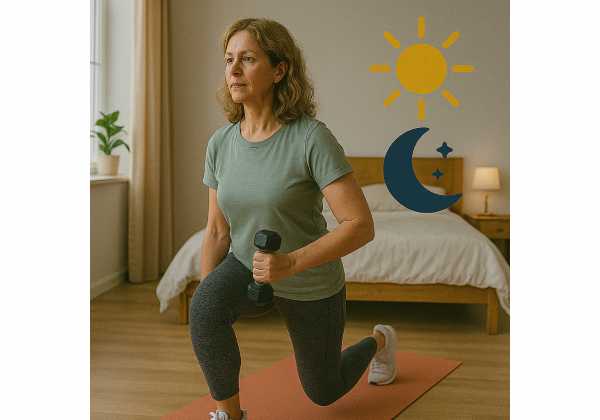
Midlife brings competing demands: heavier workloads, family duties, and bodies that recover more slowly. Training still delivers huge benefits, but when you train changes how you sleep and bounce back. Morning sessions can reinforce a stable body clock; evening sessions can fit busy schedules and relieve stress—if you cool down and dim the night properly. This guide translates research into practical timing rules you can apply this week. You will learn how intensity and timing shape deep and REM sleep, who thrives on early training, how to make late workouts sleep-friendly, and how to place strength, cardio, and HIIT across the week. We will also cover fueling, caffeine cutoffs, and simple metrics to track adaptations. For a broader recovery framework that complements training, see our practical hub on sleep, stress, and recovery.
Table of Contents
- How Exercise Intensity and Timing Affect Sleep Stages
- Morning Training: Pros, Cons, and Who It Suits
- Evening Training: Pros, Cons, and How to Wind Down
- Strength, Cardio, and HIIT: Timing Guidelines That Work
- Fueling and Caffeine Timing Around Workouts
- A Weekly Template for Training and Recovery in Midlife
- What to Track: HRV, Resting Heart Rate, and Subjective Sleep
How Exercise Intensity and Timing Affect Sleep Stages
Exercise affects sleep in two main ways. First, it changes sleep pressure—the brain’s drive to sleep that builds during wakefulness and physical work. Second, it nudges the circadian system, which sets your internal clock. The mix of these effects depends on intensity, finish time, and cool-down.
- Moderate aerobic work (easy runs, cycling, brisk walking) often shortens sleep latency and can increase slow-wave sleep the following night. This shows up as easier sleep onset and a steadier first half of the night.
- Strength training creates local fatigue and small surges in stress hormones that usually settle by bedtime if you stop early enough. Many lifters report normal or improved sleep when sessions end more than two to three hours before lights out.
- HIIT and vigorous intervals spike core temperature, heart rate, and adrenaline. Done too late, they can delay sleep onset in sensitive sleepers; done 2–4 hours before bed with a proper cool-down, they often leave sleep unchanged or slightly improved.
Timing matters because body temperature and arousal must descend to invite sleep. A late session without a taper keeps you “hot and alert” when you should be cooling and dimming. Conversely, training that ends with time to shower, eat lightly, and dim lights allows the natural temperature drop to proceed.
Age changes the equation. In midlife, recovery slows, core temperature runs higher, and sleep becomes lighter. That does not forbid evening training, but it raises the bar for wind-down quality. Two rules help almost everyone:
- Build a runway: Finish higher-intensity sessions at least 3 hours before bed; finish moderate sessions 2–3 hours before.
- Cool, refuel, and dim: A warm shower 90 minutes before bed (for rebound cooling), a light protein-forward meal, and low, warm light reduce arousal and protect deep and REM sleep.
Finally, watch your own data. If late intervals push bedtime back or increase awakenings, slide them earlier or swap them for moderate cardio in the evening and move high strain to mornings. If sleep remains solid, keep the schedule—consistency is a powerful training tool.
Morning Training: Pros, Cons, and Who It Suits
Pros
- Clock alignment: Morning light plus movement is the strongest legal performance enhancer for sleep timing. It helps anchor wake time, advance the body clock, and stabilize evening melatonin rise. Pair early sessions with outdoor light for an even stronger effect; for step-by-step light tactics, see our guide to morning light and evening darkness.
- Sleep-friendly fatigue: Training early allows a full day for core temperature, heart rate, and adrenaline to come down. By evening, you are physiologically ready to sleep.
- Habit stability: Fewer work or family interruptions. Morning training tends to be more consistent across weeks, which compounds fitness and sleep benefits.
Cons
- Performance ceiling (for some): Maximal strength and high-end power can feel better later in the day when body temperature and neuromuscular readiness are higher. You can compensate with a longer warm-up or schedule your heaviest lifts on weekend late mornings.
- Fueling window: Very early sessions may be underfueled if you train fasted. That can be fine for easy cardio but often limits quality for high-intensity or strength work. A small pre-session snack (see fueling section) fixes this.
Who it suits
- Light or fragmented sleepers, shift-prone body clocks, and anyone who struggles to wind down after late training.
- Busy professionals who want training before demands pile up.
- Weight-loss or metabolic health goals, where a long, active day after training adds non-exercise movement and supports appetite control.
Best practices
- Warm up longer. Cold tissues and sleepy joints need an extra 5–10 minutes of mobility and ramp-up sets.
- Caffeine timing. If you use caffeine, take the smallest effective dose and keep the daily cutoff 8–10 hours before bedtime.
- Refuel early. A protein-rich breakfast within 60–90 minutes prevents late-day overeating and improves recovery.
If early alarms make you dread training, start with two morning sessions per week and keep your heaviest day at midday or late morning. The goal is a schedule you can run for months, not a one-week experiment that burns out.
Evening Training: Pros, Cons, and How to Wind Down
Evening sessions can fit real life—and they can be sleep-friendly with the right finish time and wind-down.
Pros
- Performance feel: Many athletes report better perceived power and coordination in late afternoon or early evening thanks to higher body temperature and more flexible joints.
- Stress outlet: A post-work session clears mental noise and can reduce evening rumination—especially true for moderate cardio, mobility, or strength circuits.
Cons
- Short runway risk: High-intensity work ending ≤1 hour before bed often delays sleep, raises resting heart rate overnight, and can reduce sleep efficiency in sensitive individuals.
- Content creep: Bright gyms, late screens, and stimulating media after training can undo the benefits of exercise by pushing the clock later. For device and lighting setup that protects melatonin, see our hands-on guide to evening screen hygiene.
Make evening training sleep-friendly
- Pick the right window. Aim to finish 3+ hours before bed for intervals or heavy lifting; 2–3 hours for moderate cardio or circuits.
- Downshift on purpose. End with 8–10 minutes of gentle cycling or walking, then 3–5 minutes of slow, exhale-biased breathing (e.g., in 4, out 6). This accelerates the slide from “high” to “calm.”
- Heat, then cool. A warm shower 90 minutes before bed prompts rebound cooling; keep the bedroom 17–19 °C and use breathable bedding.
- Refuel light and early. Choose a protein-forward plate with cooked vegetables and modest complex carbs; avoid greasy, very spicy, or heavy meals late.
- Dim and quiet. Switch to low, warm lamps; enable night mode and lower screen brightness; keep content low-arousal.
What if late is your only option?
Swap HIIT for tempo or Zone-2 cardio, keep strength sessions to technique and moderate loads, and compress the workout to 30–45 minutes. Consistency beats perfection: a shorter, well-timed session often outperforms a heroic hour that wrecks sleep.
Strength, Cardio, and HIIT: Timing Guidelines That Work
Different modalities impose different recovery and sleep costs. Use these rules of thumb to place them smartly across your day and week.
Strength training
- Best times: Morning to late afternoon. If evenings are your only slot, finish heavy compound lifts ≥3 hours before bed.
- Sleep impact: Usually neutral or positive if you leave enough runway. Heavy late sessions without a taper can delay sleep.
- Practical tip: On late days, cap top sets, extend rest, and prioritize technique. Save true max-effort work for earlier sessions or weekends.
Cardio (Zone-2 to tempo)
- Best times: Anytime with a slight edge for morning or early evening.
- Sleep impact: Often improves sleep onset and first-half stability, especially when done outdoors.
- Practical tip: If you must train close to bedtime, keep it strictly easy—you should nose-breathe and talk in full sentences.
HIIT / Intervals
- Best times: Morning or early evening, not late night.
- Sleep impact: Fine when you finish ≥3 hours before bed and cool down thoroughly; risky inside the last hour.
- Practical tip: Reduce the last interval’s intensity and add 10 minutes of easy movement to transition.
Mobility, yoga, and breath-led work
- Best times: Evening shines here. These sessions lower arousal and pair well with dim light. If anxiety spikes at night, add 5 minutes of paced breathing; for a quick tutorial, see breathwork basics.
Stacking for deeper sleep
- Pair morning strength with a 15–30 minute evening walk.
- Pair evening lifting with a lighter dinner and breathwork.
- After HIIT, avoid big meals and bright screens late; keep fluids moderate to reduce bathroom awakenings.
If your main goal is maximizing deep and REM sleep, review our concise overview of targets by stage in deep and REM sleep goals. Then place your highest-strain sessions earlier in the day on nights you want to bank more deep sleep.
Fueling and Caffeine Timing Around Workouts
Fuel supports performance and sleep—if you time it well.
Before training
- Morning strength or HIIT: If fasted makes you flat, use a small snack 30–60 minutes prior: a banana, toast with nut butter, or yogurt (15–30 g carbs; 10–20 g protein).
- Easy cardio: Fasted is often fine; bring water and eat a normal breakfast after.
After training
- Protein: Aim for 20–40 g protein within 60–90 minutes to support muscle repair.
- Carbs: Use 0.5–1.0 g/kg carbohydrate after high-intensity or longer sessions to restore glycogen; scale down after easy work.
- Evenings: Keep post-workout meals lighter and earlier to protect sleep. If you are hungry near bedtime, pick a protein-forward snack (e.g., Greek yogurt with berries) instead of a heavy second dinner.
Hydration
- Front-load fluids during the day. In the final 2 hours before bed, taper intake to reduce bathroom awakenings.
Caffeine around workouts
- Dose: Use the lowest effective dose. Many midlife athletes do well with 1–2 mg/kg (e.g., 70–140 mg for a 70-kg person).
- Cutoff: Keep a personal cutoff 8–10 hours before bedtime; sensitive sleepers often need 10–12 hours. If you train late, skip caffeine entirely.
- Forms: Espresso often contains less caffeine than large drip coffee; caffeine gums or smaller cups allow finer control. For a fuller playbook on stimulant and evening nutrition timing, see caffeine, alcohol, and late meals.
- Supplements: Be wary of “pre-workouts” with hidden caffeine or stimulants. If you use them, reserve for morning only and note any changes in sleep latency or nighttime heart rate.
Chrononutrition matters
- An earlier, balanced dinner (protein + cooked veg + modest complex carbs) with a 3–4 hour runway to bedtime improves sleep—and next-day training quality. For schedule examples that align meals with your clock, skim our guide to meal timing.
A Weekly Template for Training and Recovery in Midlife
Use this as a scaffold and adjust for your goals, joints, and calendar. The template assumes a 22:30 bedtime and 06:30 wake time; slide times to fit your life while keeping runways to sleep.
Goal: general fitness, strength maintenance, and restorative sleep
- Mon (AM): Strength—full-body (60 min). Evening: 20–30 min walk after dinner.
- Tue (PM early): Zone-2 cardio (40–60 min), finish by 19:00.
- Wed (AM): Mobility + core (30–40 min). Optional light technique lifts.
- Thu (PM early): Intervals—moderate HIIT (e.g., 6 × 2 min hard / 2 min easy), finish by 19:00; cool down 10 min.
- Fri (AM or midday): Strength—full-body (60 min).
- Sat (AM): Longer Zone-2 (60–90 min) outdoors if possible.
- Sun (PM early): Gentle yoga or walk; no high-strain.
Notes
- Keep two lower-strain evenings (Wed/Sun) to protect end-of-week sleep.
- On days with late meetings, swap Tue/Thu with Mon/Fri AM sessions to maintain runways.
- If sleep worsens after Thu intervals, move them to Tue AM and slide Tue cardio to Thu PM early.
For lifters prioritizing strength
- Put heavy lower-body on Mon AM and heavy upper-body on Thu AM.
- Keep accessory and pump work earlier in the day if you sleep light.
- Slot HIIT on Tue AM or Sat AM to avoid late-evening arousal.
For runners or cyclists building aerobic base
- Keep two Zone-2 days (Tue/Sat) and one threshold/interval day (Thu), all with 3+ hour runways when in the evening.
- Use short, easy evening jogs (≤30 min) as recovery—not as fitness anchors.
Finally, audit your environmental cues. Bright mornings and dim evenings help every plan work better. If you need a refresher on core circadian levers, see resetting your body clock.
What to Track: HRV, Resting Heart Rate, and Subjective Sleep
Tracking should guide decisions, not create stress. Three lenses capture most of what matters:
1) Sleep diary (subjective)
- Record bedtime, lights-out, sleep latency (estimate), awakenings, wake time, and morning energy (1–5).
- Aim for sleep efficiency ≥85% most nights and latency 10–25 minutes. Note which workouts preceded your best and worst nights.
2) Autonomic markers (objective)
- Resting heart rate (RHR): Track the lowest nightly RHR or morning resting value. A trend down across weeks suggests improved recovery; spikes after late HIIT or heavy lifting indicate you need a longer runway.
- HRV (heart rate variability): Watch weekly trends, not single nights. Sustained drops after stacking high strain and late sessions mean your plan is too dense or too late.
3) Performance feel
- Rate session quality (1–5) and daytime alertness. If two late-evening workouts per week keep alertness low, move at least one earlier.
Run practical experiments
- Timing test: For two weeks, move HIIT or heavy lifting 4–6 hours earlier. Compare latency, awakenings, and morning energy with your previous schedule.
- Downshift test: Keep session times but add a 10-minute cool-down, warm shower 90 minutes pre-bed, and 5 minutes of paced breathing. If sleep improves, the issue was arousal, not timing.
- Caffeine test: Push your last dose 2 hours earlier for 10–14 days and compare sleep. If latency shrinks and awakenings fall, keep the earlier cutoff.
Use your device as a trend compass and your diary as a map. For help deciding which numbers matter, our primer on wearables that help versus distract keeps the signal-to-noise high.
References
- Effects of evening exercise on sleep in healthy participants: a systematic review and meta-analysis (2019) (Systematic Review)
- The effects of evening high-intensity exercise on sleep in healthy adults: A systematic review and meta-analysis (2021) (Systematic Review)
- Different intensities of evening exercise on sleep in healthy adults: A systematic review and network meta-analysis (2022) (Systematic Review)
- The effects of physical activity on sleep: a meta-analytic review (2015) (Systematic Review)
- Caffeine effects on sleep taken 0, 3, or 6 hours before going to bed (2013) (RCT)
Disclaimer
This article is educational and is not a substitute for personal medical advice, diagnosis, or treatment. Adjusting training intensity, timing, nutrition, and caffeine can affect blood pressure, glucose, pain, and sleep medications. Consult a qualified clinician before changing your program if you have cardiovascular or metabolic disease, chronic pain, insomnia, or symptoms of sleep apnea. If sleep problems persist for several weeks or impair daytime function, seek professional evaluation.
If you found this guide useful, please consider sharing it on Facebook, X (formerly Twitter), or your preferred platform, and follow us for future updates. Your support helps us continue creating practical, evidence-informed resources on training, recovery, and healthy aging.










